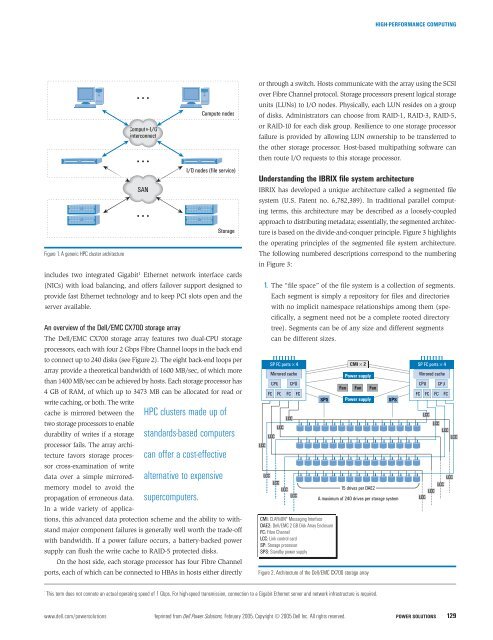Dell Power Solutions
Dell Power Solutions
Dell Power Solutions
- No tags were found...
Create successful ePaper yourself
Turn your PDF publications into a flip-book with our unique Google optimized e-Paper software.
HIGH-PERFORMANCE COMPUTINGCompute nodesCompute-I/OinterconnectI/O nodes (file service)SANStorageFigure 1. A generic HPC cluster architectureincludes two integrated Gigabit 1 Ethernet network interface cards(NICs) with load balancing, and offers failover support designed toprovide fast Ethernet technology and to keep PCI slots open and theserver available.An overview of the <strong>Dell</strong>/EMC CX700 storage arrayThe <strong>Dell</strong>/EMC CX700 storage array features two dual-CPU storageprocessors, each with four 2 Gbps Fibre Channel loops in the back endto connect up to 240 disks (see Figure 2). The eight back-end loops perarray provide a theoretical bandwidth of 1600 MB/sec, of which morethan 1400 MB/sec can be achieved by hosts. Each storage processor has4 GB of RAM, of which up to 3473 MB can be allocated for read orHPC clusters made up ofstandards-based computerscan offer a cost-effectivealternative to expensivesupercomputers.write caching, or both. The writecache is mirrored between thetwo storage processors to enabledurability of writes if a storageprocessor fails. The array architecturefavors storage processorcross-examination of writedata over a simple mirroredmemorymodel to avoid thepropagation of erroneous data.In a wide variety of applications,this advanced data protection scheme and the ability to withstandmajor component failures is generally well worth the trade-offwith bandwidth. If a power failure occurs, a battery-backed powersupply can flush the write cache to RAID-5 protected disks.On the host side, each storage processor has four Fibre Channelports, each of which can be connected to HBAs in hosts either directlyor through a switch. Hosts communicate with the array using the SCSIover Fibre Channel protocol. Storage processors present logical storageunits (LUNs) to I/O nodes. Physically, each LUN resides on a groupof disks. Administrators can choose from RAID-1, RAID-3, RAID-5,or RAID-10 for each disk group. Resilience to one storage processorfailure is provided by allowing LUN ownership to be transferred tothe other storage processor. Host-based multipathing software canthen route I/O requests to this storage processor.Understanding the IBRIX file system architectureIBRIX has developed a unique architecture called a segmented filesystem (U.S. Patent no. 6,782,389). In traditional parallel computingterms, this architecture may be described as a loosely-coupledapproach to distributing metadata; essentially, the segmented architectureis based on the divide-and-conquer principle. Figure 3 highlightsthe operating principles of the segmented file system architecture.The following numbered descriptions correspond to the numberingin Figure 3:LCC1. The “file space” of the file system is a collection of segments.FCEach segment is simply a repository for files and directorieswith no implicit namespace relationships among them (specifically,a segment need not be a complete rooted directorytree). Segments can be of any size and different segmentscan be different sizes.SP FC ports ¥× 4Mirrored cacheLCCCPUFCLCCFCLCCCPUFCLCCLCCLCCLCCSPSCMI: CLARiiON ® Messaging InterfaceDAE2: <strong>Dell</strong>/EMC 2 GB Disk Array EnclosureFC: Fibre ChannelLCC: Link control cardSP: Storage processorSPS: Standby power supplyFanCMI ¥× 2<strong>Power</strong> supplyFan<strong>Power</strong> supplyFanSPS15 drives per DAE2A maximum of 240 drives per storage systemFigure 2. Architecture of the <strong>Dell</strong>/EMC CX700 storage arrayFCSP FC ports ¥× 4Mirrored cacheCPUFCLCCFCCPUFCLCCLCCLCCLCCLCCLCCLCC1This term does not connote an actual operating speed of 1 Gbps. For high-speed transmission, connection to a Gigabit Ethernet server and network infrastructure is required.www.dell.com/powersolutions Reprinted from <strong>Dell</strong> <strong>Power</strong> <strong>Solutions</strong>, February 2005. Copyright © 2005 <strong>Dell</strong> Inc. All rights reserved. POWER SOLUTIONS 129








